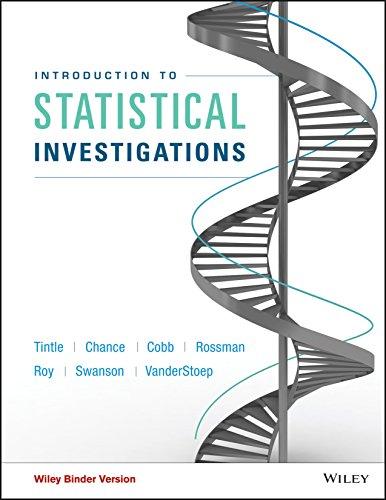Reconsider the exercise in Section 5.1 about Medicare audits (5.1.6). Of the 30 small claims, 14 were
Question:
Reconsider the exercise in Section 5.1 about Medicare audits (5.1.6). Of the 30 small claims, 14 were judged to be over payments; of the 30 medium claims, 8 were judged to be overpayments. Our research question is this: “Does the chance that the claim is judged to be an overpayment tend to differ by the size of the claim?”
a. Which of the following is the appropriate null hypothesis? Choose one.
A. Small claims are more likely to be judged overpayments compared to medium claims.
B. Small claims are less likely to be judged overpayments compared to medium claims.
C. Small and medium claims are equally likely to be judged overpayments.
D. Small and medium claims are not equally likely to be judged overpayments.
b. Which of the following is the appropriate alternative hypothesis? Choose one.
A. Small claims are more likely to be judged overpayments compared to medium claims.
B. Small claims are less likely to be judged overpayments compared to medium claims.
C. Small and medium claims are equally likely to be judged overpayments.
D. Small and medium claims are not equally likely to be judged overpayments.
c. In this context, which of the following is an (are) appropriate statistic value(s) to compare small to medium claims? Choose all that apply.
A. 14/60 − 8/60 = 0.10
B. 14/30 − 8/30 = 0.20
C. 14/22 − 16/38 = 0.22
D. (14/30)/(8/30) = 1.75
Suppose that we want to use cards to carry out a randomization test of the appropriate hypotheses.
d. How many cards will we need? Choose one.
A. 30
B. 52
C. 60
D. Doesn’t matter
e. We need cards of two diff erent colors. Let’s say we decide to use red and black cards. Which of the following is an appropriate combination of red and black cards? Choose all that apply.
A. 14 red and 8 black
B. 30 red and 30 black
C. 22 red and 38 black
D. 38 red and 22 black
f. You shuffle the stack of red and black cards and deal them into two piles. How many cards should you place in each pile? Why?
g. What statistic should you record aft er you have shuffled and dealt the cards into two piles? (Hint: Th ere is more than one correct answer here.)
h. Suppose that you have repeated the shuffle-and-deal many times and recorded the appropriate statistic every single time. What should you do next to find the p-value?
Step by Step Answer:

Introduction To Statistical Investigations
ISBN: 9781118172148
1st Edition
Authors: Beth L.Chance, George W.Cobb, Allan J.Rossman Nathan Tintle, Todd Swanson Soma Roy





